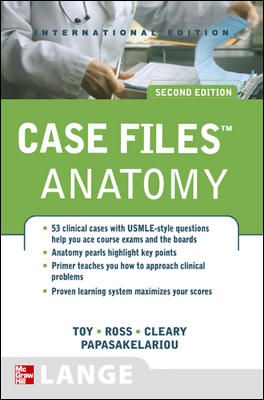Case Files: Gross Anatomy (Int'l Ed)
2nd Edition
0071278192
·
9780071278195
© 2008 | Published: June 20, 2008
Fifty clinical cases help you excel at your anatomy coursework and the USMLE Step 1The Case Files series is an award-winning learning system proven to improve exam scores. This series helps you to learn in the context of real patients instead of sim…
Read More
Receive via shipping:
- Colour, print bound version of the complete text
Case Files: Gross Anatomy: Second Edition
Introduction
- Approach to Learning
1. Upper Extremity
Introduction
Section I: Applying Basic Sciences to Clinical Situations
- Approach to Learning
- Approach to Disease
- Approach to Reading
Section II: Clinical Cases arranged by zone
1. Upper Extremity
2. Lower Extremity
3. Thorax
4. Abdomen
5. Retroperitoneum, Posterior abdominal wall
6. Perineum and Pelvis
7. Nervous system
8. Head and neck
9. Face and scalp
Section III: Listing of cases
- By System
- By Alphabetical Order
3. Thorax
4. Abdomen
5. Retroperitoneum, Posterior abdominal wall
6. Perineum and Pelvis
7. Nervous system
8. Head and neck
9. Face and scalp
Section III: Listing of cases
- By System
- By Alphabetical Order
5. Retroperitoneum, Posterior abdominal wall
6. Perineum and Pelvis
7. Nervous system
8. Head and neck
9. Face and scalp
Section III: Listing of cases
- By System
- By Alphabetical Order
7. Nervous system
8. Head and neck
9. Face and scalp
Section III: Listing of cases
- By System
- By Alphabetical Order
9. Face and scalp
Section III: Listing of cases
- By System
- By Alphabetical Order
Fifty clinical cases help you excel at your anatomy coursework and the USMLE Step 1
The Case Files series is an award-winning learning system proven to improve exam scores. This series helps you to learn in the context of real patients instead of simply memorizing. Case Files: Anatomy: Second Edition presents more than 50 clinical cases with open-ended questions which weave basic science concepts into the clinical scenario. Each case includes an extended discussion (including definitions and a pathophysiology discussion), key points, and 3-5 USMLE-style comprehension questions. The authors are experienced teachers from the University of Texas-Houston Medical School in Houston, Texas.

